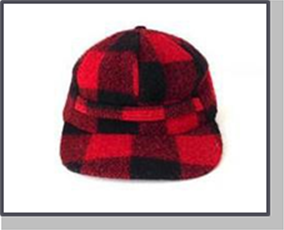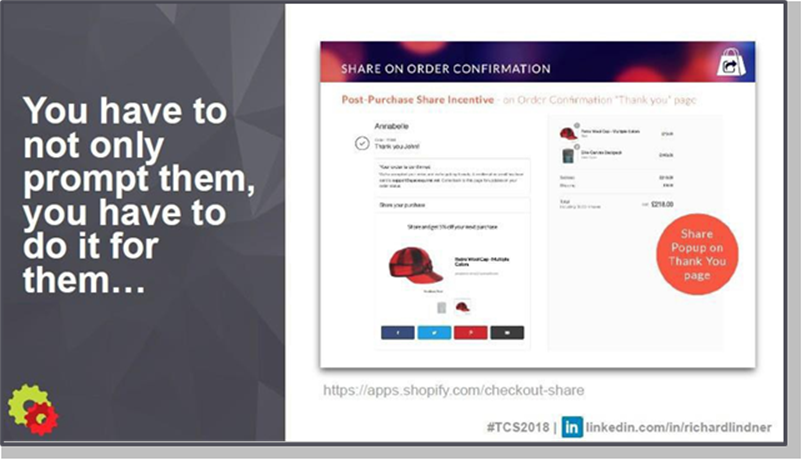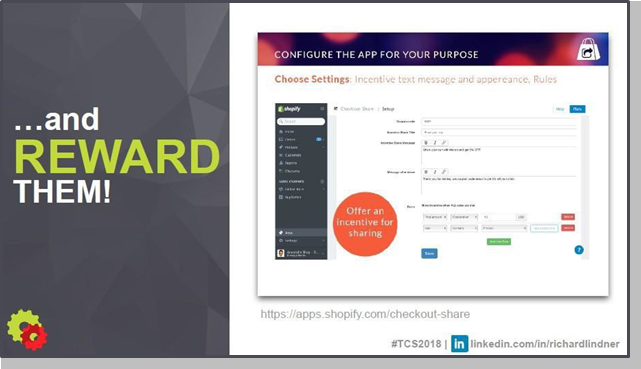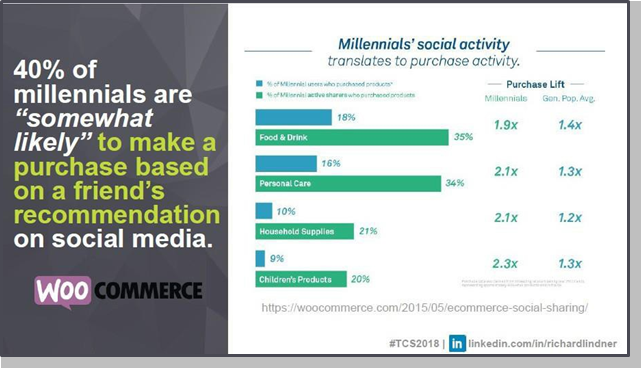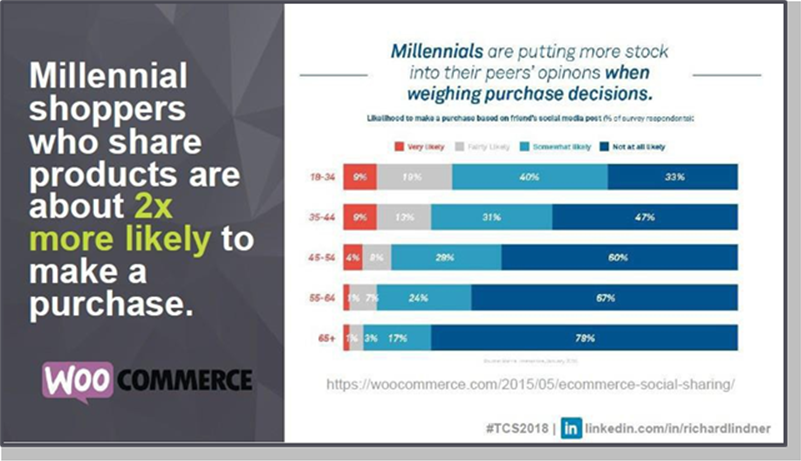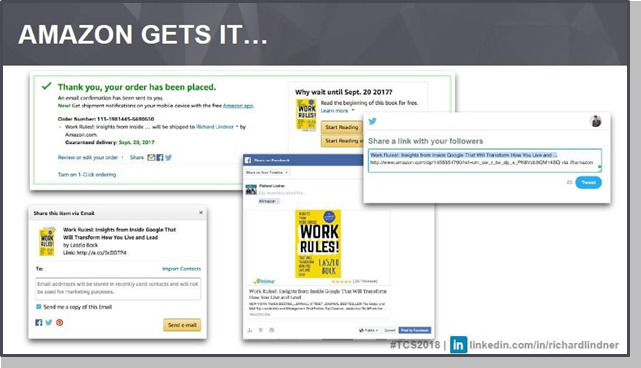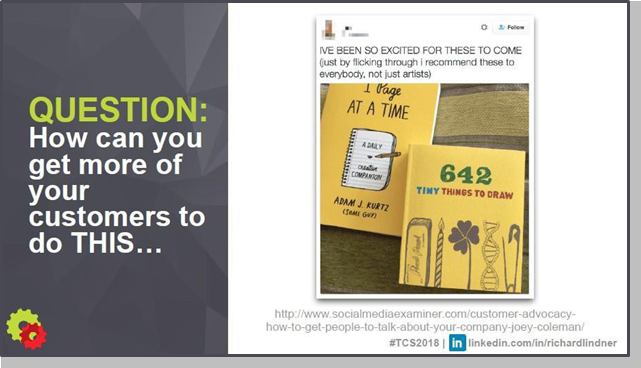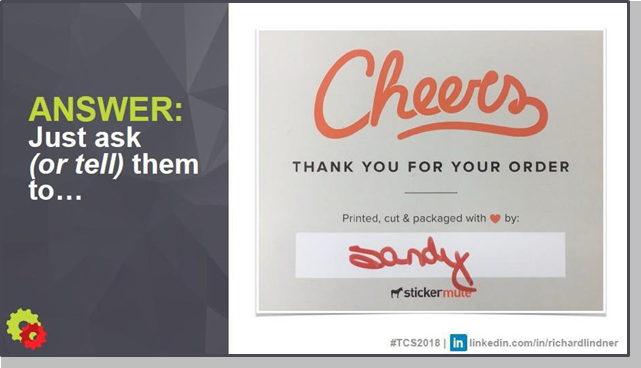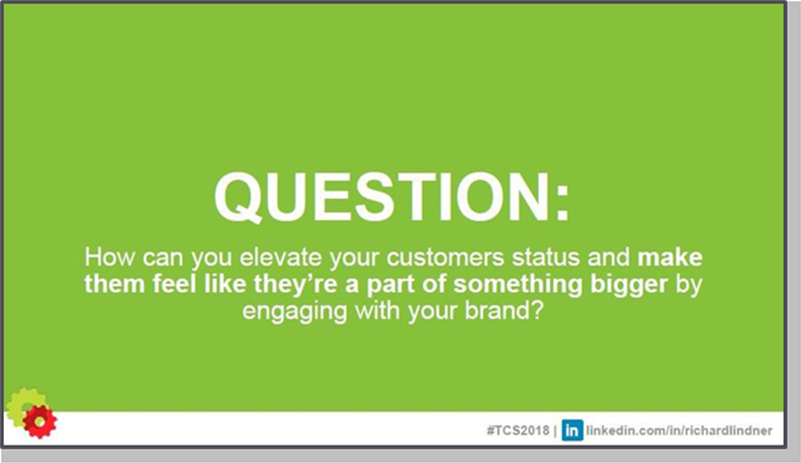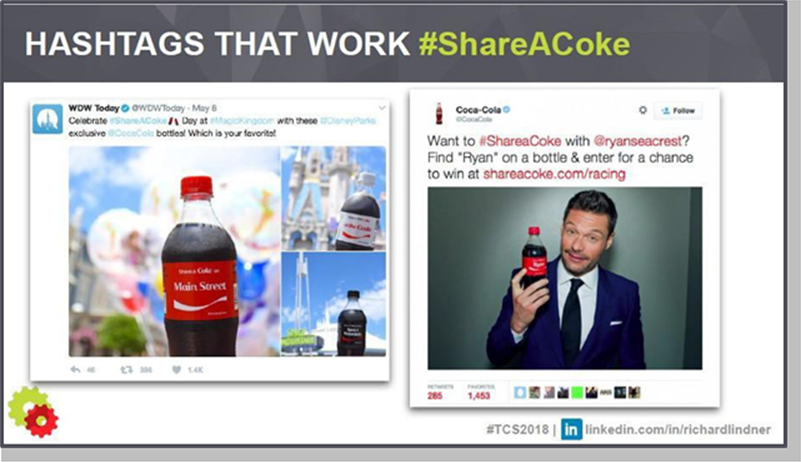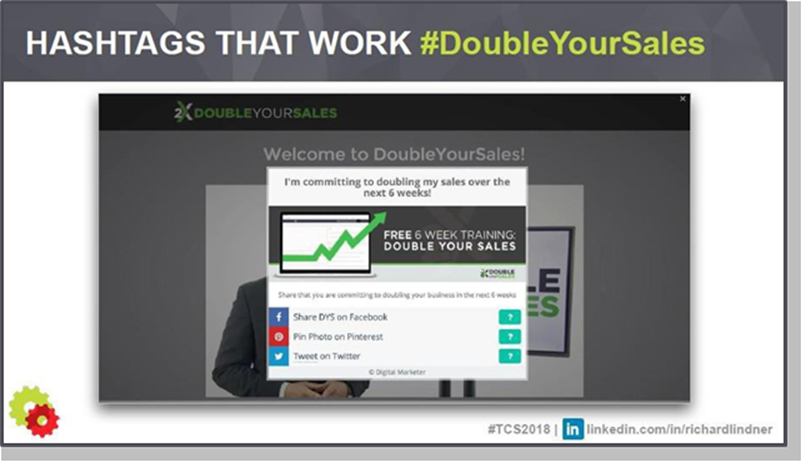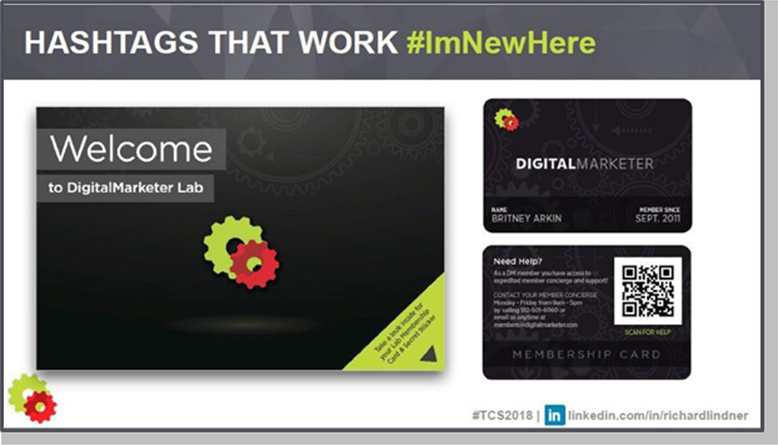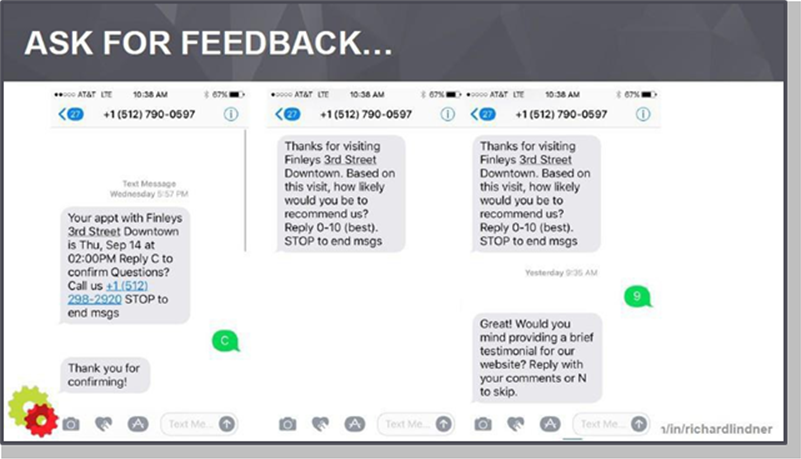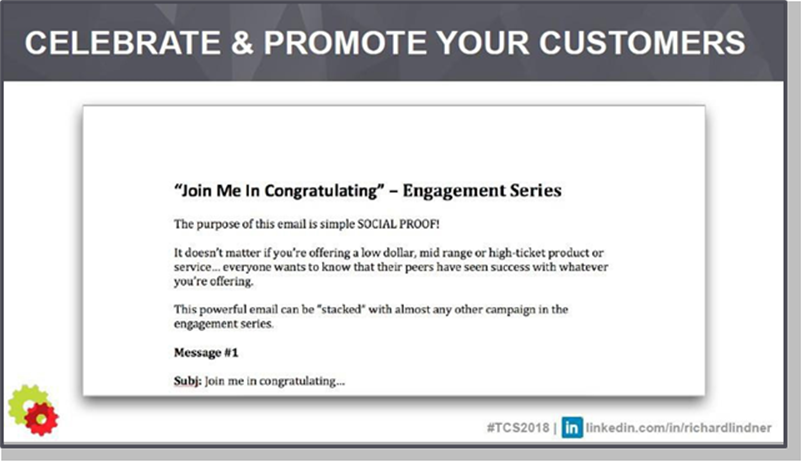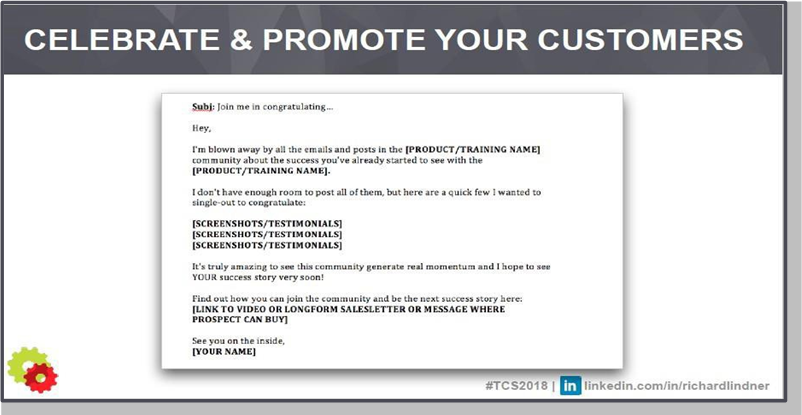Richard Lindner
Richard Lindner is the President and Co-Founder of DigitalMarketer, the industry leader in global digital marketing education. While running a global team of more than 50 professionals worldwide, Richard also is a sought after executive leadership expert, working with some of the world’s most exciting brands like Uber, Harper Collins, Infusionsoft, Maropost and Ethiad Airlines to name a few.
It’s one thing to focus on getting new customers. Yes, we want to do things that drive more traffic and increase conversions, but what if there were a way that you could turn each of those customers into three? What if there were a way to turn your happy customers into brand evangelists who promote your brand, bringing more customers just like them?
When it comes to your business, the customer is your hero. Without them, where would you be? It is important never to forget that. But what is even better is finding a way to guide them, to help them become their own “heroes” – doing things to help others and make themselves feel good.
This article will give you a five-step plan that will not only help you turn your customers into brand promotors but will also enable them to fulfill their ultimate destiny.
When we do that, the byproduct is your customers are happy, your customers are successful no matter what you do. And when you have happy customers, it’s easy to have those happy customers bring you other customers. Because they already like you.
I love this quote from Peter Drucker: “The purpose of business is to create and keep a customer.”
Actually, I prefer this quote from Shiv Singh a little better: “The purpose of business is to create a customer and the final aspect of that is, who creates other customers.”
And that’s firmly what I believe, it’s what we believe at DigitalMarketer, that’s why the customer value journey is so important. But you’ll notice, when taking someone from a “where to subscribe” position to convert to excite, the very last stage in this journey is promote.
We all want our customers to be promoters of our brand, but it has to be done carefully, with the right timing. Despite what everyone says, it absolutely does hurt to ask too soon. Sometimes it hurts a lot, so you need to make sure that if you’re asking your customers to promote you or your brand, that you’re doing it at the appropriate time.
You don’t ask a customer to refer you another customer as soon as they’ve become your customer. They’ve had no time to experience any value from you. When most brands launch referral programs, when most brands try to tap their best customers to bring them more customers to grow their business, and to grow their business on an acquisition that’s already been spent or that you’ve already paid to acquire that customer, this is too soon
and often does not get the desired result. It’s not that it doesn’t work because no one wants to tell their friends about you. It’s that it doesn’t work because they ask at the wrong time, and what’s worse is that by asking too soon,
it may actually backfire, losing the opportunity to get a promotion from someone who may have done it, if you only waited.
You should never ask for a referral unless you’re 99% sure they will say yes.
In fact, there’s several things in life that you should never ask for unless you’re 99% sure the person you’re asking will say “yes.” Like, “Will you marry me?” You should never have your fingers crossed if you’re going to ask that question. This is not different from asking your customers “Would you be willing to tell your friends about me?” Those two things, you should know ahead of time that 99% sure they’re going to say “yes.” Make sense?
Okay, so how do you know when your customer’s ready to say “yes” to promoting you and your brand. This is the customer advocacy curve. This is the experience that you need to take a customer through intentionally to get them from knowing about you to making a purchase to bringing you their friends and feeling good about it.
The Customer Advocacy Curve
When you follow the six stages of the customer advocacy curve you can create a process to intentionally drive customers through this in your business.
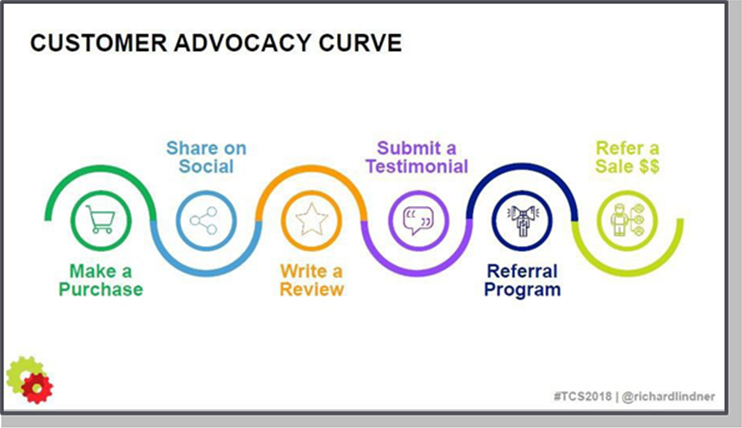
Stage 1 – Make a Purchase
Phase one of the customer advocacy curve is to get them to make a purchase. Right? They have to actually be a customer if there’s going to be a referral program. If not, they don’t know why they should tell someone to come to you because they haven’t experienced any value from you.
Stage 2 – Share on Social
The second step is they need to share or mention you on social. We’re going to talk a lot about micro-commitments – small steps to move people along the curve. Remember it hurts to ask too soon so we need to know they’re going to say yes, so how do we do that? How do we insure they’re going to say yes? We walk them down a path and if they don’t do a small portion of it, we don’t ask for the next step until they do. So, after someone makes a purchase, the best thing you can get them to do is mention you on social.
Not say, “Go buy from this person!” but just mention you or your brand in some way.
Stage 3 – Write A Review
Then we’re going to move on and ask for a little smaller commitment. We are going to ask them to write a review. This is great on physical products, but it works no matter what you’re selling. If you’re an agency, if you’re a service,
if you’re selling information or training, it doesn’t matter. Facebook reviews, Google reviews, Amazon reviews, if someone shared you on social let’s get them to say something nice about the experience that they had.
Stage 4 – Submit a Testimonial
The next step in the process, is they need to give a testimonial, a customer story or maybe a case study. We’re walking them down the phases of becoming a brand advocate and then a promoter, right? They need to do some things first before we jump right in and ask them to send their friends and family.
Stage 5 – Join Referral Program
Then, after someone’s submitted a testimonial and done these other things, now it’s the appropriate time to ask them to join a referral program because they’ve proven that they’re willing to buy from you, to talk about you, to share their experience. Now we can take the step to ask them to really get in there and go from advocate to intentional promoter. And that’s what we’re looking for: a conscious shift from “I’m willing to say nice things about this brand”
or if someone asks for a referral “I’m willing to then refer this brand,” to “I’m going to intentionally and proactively go out and tell the masses about this brand.”
What if your customers did that? What if every customer you had, or what if one in five customers you had, it became their mission to indoctrinate the world to your existence. What would happen to your business? Think it’d get bigger or smaller? Bigger of course!
Stage 6 – Refer a Sale
Now we can bring the customer to the final stage – getting them to refer a sale. After they’ve done the other things, and after they’ve joined a referral program and they refer a sale, now we’re going to really dive in because what you have is a promoter.
What you have is someone who has moved from customer to intentional promoter of your brand. But how do you do it, right? How many times does that just happen in your business? Is it one in a hundred? Is it one in a thousand? Is it the customer that’s coming to you and saying, “Is there any way I can promote your brand?” No, this doesn’t happen organically.
Five Steps to Turn Customers into Advocates and Promoters
When it comes to bringing your customers through the advocacy curve from purchaser to an advocate who consciously promotes your brand, there are five steps apply to your business to make this happen: identification of the trigger, then comes enabling, rewarding and perpetuating it, and finally getting them to repeat the behavior.
So, let’s start by quickly going over those steps and then we’ll take a deep
dive into each one.
The first thing we need to do is identify the trigger. There’s a triggering event for someone moving through that advocacy curve. There’s some triggering event that happens after someone makes a purchase to indicate they’re willing to share you or your brand on social. And then there’s a triggering event of that share that tells you it’s time to ask for a review and then when you get a review. There’s a triggering event that says, “Okay we need to move to the next step.”
To move to the next step of encouraging the trigger, we have to figure out, “What is the triggering event? What is the thing that happens that makes them willing to talk about you or your brand socially?”
Think about this for a second. When was the last time you woke up, maybe you had a long night, maybe you pulled an all-nighter and worked really hard? Or maybe you had a few too many drinks, and you woke up and you
looked like a special kind of rough? I mean hairs all jacked up, or for the
ladies your makeup didn’t come off before you went to bed – and the first thing you thought was, “Hold one, lemme get a picture of this, I gotta post it to social media.” Right? We don’t do that, we only post brand-elevating things to social media (in this case, thinking of ourselves as the “brand”).
When was the last time you boarded a Southwest flight, you’re in the middle and the very back, and you were like, “Hold on, #lessthancoach.” You don’t do that. No one does that. If it’s not brand-elevating or status-elevating, we don’t put it on social media.
How can you make your customers have an elevation of status by sharing something of yours? It’s not: look what I just bought. That’s not an elevation of status unless you’re a luxury brand and then that’s still just a humble brag. Once we identify the trigger, we need to encourage and enable the trigger. We know what it is that they feel that indicates they’re ready to do something. Now, we need to be able to encourage it because remember, this isn’t happening organically in any of your businesses. No customer’s like, “Well I’m here on the customer advocacy curve and I think by the end of the day if I play my cards right I can get to the end!” You’re just not that important in their lives.
The next thing you need to do is reward the trigger, right? Small rewards, micro-commitments, these are the things that take customers from customers to brand advocates to intentional promoters. And then you need to perpetuate the trigger, right, and we’ll talk about that as well.
And then the final step is to get people to repeat the process. So once someone makes the first referral sale, you don’t want to stop there, right?
Whatever you give them, whatever you reward them with after they’ve referred the first sale, that’s just taking them from a one-time promoter and figuring out, “How do we get them into a constant promoter of my brand?”
So, there’s the steps and instead of just leaving you with them to try to figure it out on your own, let’s go through and break them down one by one. Sound good?
Step 1 – Identifying the Trigger
To identify the trigger, you must answer this question, and this is a big one so please pay attention. When is your customer most excited about you, your product, your service, or your brand? Remember, we’re trying to figure out triggers.
What is a triggering event that would be an organic transition from a way they feel to getting them to speak about you publicly? How do we get them to feel something and then they’re willing to talk about you in a way that
is status-elevating? How can you encourage them to share that excitement publicly, so their friends see it?
Remember, we’re not going from purchase to “Why don’t you go tell all your friends about me?” We’re going from purchase to “Why don’t you talk about me?” There is a big distinction between the two – both in terms of the actual actions they take, and the level of commitment.
Back to the customer value journey. What we’re talking about is the excite phase, right? Your very first job is get the customer to admit sometimes to themselves, sometimes to themselves and publicly that they’re excited about your product or service.
Our lives have gotten so boring and we’re used to just being bored and unexcited that sometimes we need to tell someone like, “Isn’t that exciting? Like holy crap, that is exciting! How did I not realize that?” Sometimes the person that needs to be excited about you and your brand, they need to know is them. And all you have to do is tell them to be excited.
Before we move forward, let’s take a step back and talk about the three heights of customer excitement, because without this feeling of euphoria, it will be hard to get them to take the desired actions we need them to that will move them from buyer to active promoter.
Three Heights of Customer Excitement
There are three times within the buying process where people experience heightened emotions and a feeling of excitement: immediately after making the purchase, immediately after they receive the product (or get it home), and immediately after receiving the promised benefit.
Each of these produces a euphoric reaction, due to the release of what Loretta Breuning refers to as “Happy Chemicals” in the brain.
Purchasing releases chemicals and we get happy because we gave our money away in exchange for something else. It doesn’t make a lot of sense, but it’s true. The first time your customer is the most excited about you or your brand is the second that they’ve made a purchase. They are super excited, right?
The second they’ve made a purchase they know that this is going to solve all their problems, make them skinnier, more attractive, richer, whatever it is.
This is a point in which they believe whatever you told them, and they haven’t yet received the value, but they’re the most optimistic that they will. So, the first time that someone is experiencing this excitement is right after they’ve made a purchase.
Now, the second time your customers are most excited is immediately after receiving the product or service. Some of you guys have digitally delivered stuff, some of you guys ship things in boxes, some of you guys are service providers. Now, if you’re going out and actually providing a service, how do you maintain excitement if you’re providing services from purchase to end result? The first excitement comes from ordering your service, knowing that you are “on the way” to giving them what they need from you. If you’re in a service industry — maybe you’re an agency, maybe you go through and you do an audit and you provide the report of findings — they’ve now started to receive something and the future that you’re providing is becoming clearer, bringing the second wave of excitement.
From there we come to the point at which your customer is the most excited about you, your product, or your service — immediately after receiving the promised benefit. Now for most people, this is also the hardest to target.
The highest level of excitement is not when they bought it, it’s not when they got it, it’s when they received the promised benefit.
When did they go “aha, I get it!”? Because that’s what we’re watching for. If
we could watch our customers, we’re watching for their eyes to light up, we’re
watching for them to go, “It did it! It worked! I got it, I get it. Yes!”
And that’s when we need to step in and say – “Hey, why don’t you talk about me on social?” – when they are at this peak of euphoria.
Right, again they didn’t wake up and go, “Wow I look like crap today, let me get a quick selfie.” If your product or service hasn’t gotten there yet, they still feel like their “before” state, not their “after” state. They still feel like they did when they determined that they needed a solution that you could provide but haven’t given yet. So, you have to be careful about when you’re asking, remember, right now you just want them to share or talk about you on social. That’s it. Alright, that’s it. You can’t expect them to do it on their own. This is not happening organically.
Remember, while you’re sitting here a new customer is not buying going, “Well gosh, I don’t feel like I paid enough for this product or service so I might as well give him a shout out to my followers.” That’s not happening. You not only have to prompt them to do it, you must do it for you.
E-commerce gets this. What I don’t see is enough people who aren’t in
e-commerce doing it. The second that they make a purchase, remember, that’s their first point of super excitement. Chemicals have been released, they’re excited about you and your brand, and depending on what you’ve sold, it could be somewhat status elevating, so prompt them to share it.
The thank-you page, the confirmation page, this is the #1 place to begin the customer advocacy journey, the customer advocacy curve happens right here. If they can share with one click that doesn’t drive back to something that they feel is going be weird to share.
Let’s use the example of buying a hat as pictured above. If you like that hat, you know what your friends like? Hats like that. You don’t hang out with dudes wearing Tom Ford suits if you’re wearing that hat. You guys are in the woods and that’s awesome. And you want your buddies to get a discount on that hat so you can look the same when you’re in the woods.
This is such an easy deal, share and get 5% off your next purchase. That’s status elevating. “My buddy would love this hat, man. I shared it, he got 5% off, I did that for him.” Status elevating. Seems simple, but are you doing it?
Here’s what I love about the best strategies, right? They’re simple, not easy. Simple, not easy. Simple, but so many people are not doing them. Have a Shopify website? This could be implemented if you’re using Shopifier, as in the image above. Use a different platform? I bet you there’s 15 plugins that could do this in just a few minutes. Most of these have simple settings that have a built in “reward” system. What do they get? What do they share, what do they get?
Now, you need to make sure that when you’re creating your share images for after a purchase, that the reward is status elevating. That the message is status elevating. The best way to do that is something along the lines of, “I got you this deal.” Because remember, we all hang out with people who like the same things we like. So, if they’re making purchases, whether it’s
digital, whether it’s physical, whatever the product or service you’re selling is, more than likely the person who bought it has friends who would also like it. Because we hang out with people who like the same things that we like.
We have to reward them though. In the example above, the reward is 5% off for the person that you share it with, but they’re also incentivizing the person who share it because it feels good to get their friends a deal. When choosing the reward, you have to make sure the incentive is appropriate.
Let’s look at this graph from WooCommerce. 40% of millennials are somewhat likely to make a purchase based on a friend’s recommendation. Right, somewhat likely. But look at these categories: food and drink, personal care, household supplies, children’s products. What do you think it is if we’re not talking household supplies? What do you think it is on clothing, on information?
The thing I love the most about millennials is their thirst for information. They are passionate about learning, they don’t expect the traditional education to provide them what they need. So, now more than ever if you’re selling information, if you’re selling education, if you’re informing and improving someone’s life, they are far more likely to share that with their friends. Right, and look, 40% more likely to buy.
Here’s the other kicker. Millennials, millennial shoppers who share products, are about two times more likely to make a purchase. Getting your customers to become promoters by prompting them to make these micro-commitments not only gets them to bring you more customers just like them, it also makes them better customers.
Let’s take look at an example: DirecTV who has an amazing rewards referral program. You give 10, get 10, right? I get 10 bucks off my bill if I send it to you and you join DirecTV. Now, if I do that to 10 of my friends, now I got
$100 off my bill and I’ve told everybody that they should be DirecTV, how likely do you think it is that I’m going to cancel DirecTV? I’ve become a promoter, I’ve told my friends. If my friends come back and say, “Oh did you catch that thing on DirecTV?” And you say, “No, I canceled.” You bet I will hear, “Wait you told me to buy it?”
“Yeah, sorry.” I can’t tell my friends to go do something and then me stop doing it without taking a depreciation of status or making myself look foolish, like I told you to do something because I wanted the money. You don’t do that to your friends.
Here’s another example: Amazon gets it. Make a purchase on Amazon. Look how simple it is to share information about it. You want to make an ease of ascension to promoter? Look at the brands people are used to buying with. You should always go and check out Amazon or check out whatever the industry specific is for you. But go back, who has the most shoppers on the planet? Amazon. What do they do? Well, they do this. I buy something, tells me, “Great, you’ve placed your order!” Now it’s going to ask me to share and look, what don’t I have to do? I don’t have to think about what to say. They’ve filled this out for me. Just import your contacts, we’ll tell everybody. Why,
I just bought a book. What do people I hang out with likely enjoy doing? Reading books about this, work rules, how to be like Google. My friends would probably enjoy this book, but it’s not just email. Go ahead and post it on Facebook, share a link on Twitter.
Now, let me ask you this: Do you think it would be status elevating for me to share that I just bought a book? Yes! Yes, for me, if I’m sharing a book purchase then it’s going to be somewhat status elevating because, “Look, I’m smart!” Whether or not I read it or not, I’m smart, I bought a book.
Now, if I bought a video game, which I do, I’m probably not going to share that. But why? It’s not status elevating to be like, “Guess what I’m gonna do this weekend! Act like I’m 15.” However, there are lots of people who play
video games, and have friends who do to, so that sharing would be elevating
to them.
Amazon gets it – putting it right out there, nice and simple, and giving buyers the option of whether to share or not. It’s low-friction sharing, it’s that first transaction that’s going move them along the path.
The question is: how can you get more of your customers to do something like this?
Look at that example, this person was so damned excited. When? At the second point of excitement when they received the product or service that they just couldn’t help but to share a picture of it. They unwrapped the box of something they bought, God knows how long ago, and the first thing they thought is, “I can’t wait to tell people I got this.”
Now I’m going open it and start doing it, but how do you think this happens? Because remember, this stuff doesn’t happen organically. How does someone go from, “I bought it, it got here, God before I start using it I just have to tell my friends?” You ask them.
At the DigitalMarketer booth we had these really cool stickers. I got some so that I could give them out to audience members because I firmly believe that in the act of referral if you put my logo on something you’ve likely paid thousands of dollars for, you’re going to be pretty damn open to telling you friends about me.
So, stickers are also a great way to encourage promotion, but that’s not the point of this story. When I opened the box of 2,500 stickers, there was a thank you card inside, with the name of the person who made and packaged them. I though that’s awesome and I said, “Oh look, Sandy made these stickers!God bless Sandy.”
And then on the back of the card, Sandy said, “Gotta sec? Share a photo or video on Instagram and mention Sticker Mule — to do what? — To make us feel loved.”
So, is that status elevating for you? Maybe it’s not status elevating, but you just made someone feel loved. Wow, I’m such a good person. I didn’t just make “someone” feel loved. Who did I make feel loved? Sandy, Sandy feels loved because I took two seconds. I went to Instagram, I know I’m supposed to go to Instagram because it tells me, and I just mention Sticker Mule.
Now, if they’re smart, the second that I did that they would reply and then move me down that advocacy curve, because that’s what we’re trying to figure out to do. Remember, what’s that triggering event? Well for Sticker Mule, they ought to be following social media anytime someone mentions that and shows a picture of their sticker. They should know that that customer is moving down that advocacy curve and they need to quickly ask for the next step. Remember, how do you perpetuate it? Sticker Mule has it figured out.
Stick a card in the box when you ship something and ask them at the second point of excitement to talk about their brand.
Step 2 – Encourage and Enable the Trigger
So, next you have to answer this question: how can you elevate your customer’s status and make them feel like they’re a part of something bigger by engaging with your brand? This is super important, remember, we’re not posting our “less than coach” experiences on Facebook for all our friends to see.
Let’s take a minute to talk about enabling promotion.
How do we do this? Create and promote a brand hashtag for your business. Hashtags are powerful. People like them. They’re silly and you can’t really always tell where one word stops and the other one starts. Who doesn’t like things like that? Ask for feedback, right? We’re enabling promotion because we’re moving them down.
If someone gives you feedback, email, text, survey, call them, ask them to review you. This is an indication that they’re willing to go to the next phase of promotion for you or your business.
Enabling Promotion – Create and Promote Brand Hashtag & Run Contests with Them
Run a contest and include the hashtag. Celebrate and promote your customers on your owned media. Remember, if elevation of status is what they’re looking for, what do you think happens to me if Audi or Range Rover or Yeti takes a picture that I submitted of me using their product and shares it to their social media following. Does that elevate my status? Come on, yes, it’s status elevating, right? So how do you do that? How do you give them what they ultimately want?
Let’s look at a couple of brands who did it well. These are some hashtags that really, really worked. There some of the best marketing hashtags that have ever been on.
“Share a Coke,” right? Coca-Cola did an amazing job with Share a Coke and the next thing you know, Share a Coke turned out to putting the most popular names directly on bottles of Coke so that not only did you take a picture of Share a Coke, it encouraged additional purchase.
For example, you’re at the store, you see your friend’s name on a Coke, you’re going to buy that Coke and take it to them, take a picture of them, #shareacoke. Take my brand and put it out into the world. Thank you very much, social media, right?
DigitalMarketer worked together with Infusionsoft, friends of DigitalMarketer for a long time, to create a free course called “Double Your Sales.” We wanted to make sure that this course not only enabled people to double their sales, but we also had them bring us other people who should want to double their sales.
So, immediately after registering for Double Your Sales, we had a prompt for them to share and we didn’t even ask them to buy anything. Right, we’re asking them to just share something free because the transaction that just occurred was free.
After they’ve done it, here’s a little extra credit that we had. We asked them to share a message on Facebook that said: “I’m dedicating the next six weeks to doubling my business, if you see me screwing around, ask me how it’s going, #doubleyoursales.” This was shared by about one in every ten people who registered for that course. Which brought us a ton of traffic.
When you join DigitalMarketer Lab, we send you a physical kit. Why? Because when’s the second time you’re most excited? When you receive the product.
So, when you join an online membership we send you a welcome kit with a membership card not only so that you have something tangible in your hands, but also so we can give you some instructions that will move new members along in the process.

We have a hashtag “I’m new here.” We put it there because we need you to move along the advocacy curve, I need you to enter a conversation. So, we even tell them what to say: use the #imnewhere, post a Facebook ad campaign, or your landing page, ask people to review it.
Enabling Promotion – Ask for Feedback
Ask for feedback. This is amazing. The barbershop I go to in Austin, I went for the first time, I confirmed my appointment on the app, and right after I got
a “Thanks for coming,” I get this next text that says, “Hey, thanks for visiting us downtown. Based on this visit, how likely would you be to recommend us, reply 0-10, 10’s the best.” So I said, “Nine.” It said, “Great!”
What’s the next stage of advocacy? Would you mind providing a testimonial for our website? Yes or no. This was done in text message, right? In text message.
Enabling Promotion – Celebrate and Promote Your Customers on YOUR Social Media
Celebrate and promote your customers, remember status elevation is what we’re looking for so all you have to do is elevate the status of your best customers. Right, it’s a reward in itself. Send out an email and say, “Hey, join me in congratulating this person who did the thing at which I promise my customers I will do.”
This does two things. One, it elevates the status of that customer and they’ll likely share it with their friends. Whether it’s an email forward or a social share. Two, it teaches the customers reading it how they will be rewarded, when they do what you want them to do.
Alright, so now that we know how to encourage that, how do we reward the trigger? Because remember, at this point we need to start giving them, their taking micro-commitments, we want to give them micro-rewards because we want to move them down this curve.
Step 3 – Reward the Trigger
First thing you must answer is: how can you motivate and incentivize your customers to graduate from sharing your content and hashtags to directly telling their friends and family to buy from you? On the customer value journey, to ascend your customer from passive to active advocate, you need to get them to share their story and give a testimonial.
We’re in the ascension phase, right? They’ve subscribed, they’ve converted, they’ve been excited. We’ve got to ascend them to advocate. Remember, they’ve shared on social, they’ve written a review, now we have to get them to submit a testimonial, right?
What do we do to reward them once they’ve done this though? Here’s a mistake: don’t give them cash. This is a referral program. This is brand
ambassadors. This is not affiliates. I’m not saying one’s bad, one’s good. My motto in life is always it’s never in lieu of, always addition to. Do I think you should have an affiliate program or a reward program?
Yes, both. Do I think you should treat your customers like affiliates? No, I do not. Treat them like referrals.
So, what do you give them if you’re not giving them cash? Thank you, acknowledgement, thank you.
Most people want to be recognized, in any way. How many times do you go out of your way just to tell someone “thank you” in a day? Not a whole lot, none of us do. I mean we try, we have the best of intentions and even if you do, how many times do you think most people are just: here thank you, you know, thank you for coming to my session, I appreciate that. There were four other choices and you came here so I really appreciate that.
Right, that’s it. “Thank you” is a reward, a shout-out.

Most people also want to be famous, at least a little bit. Right, give them a shout out. How do you give a shout-out to someone on social media? If it’s brand elevating or status elevating, a shout-out on social media could be incredible, swag, stuff they can’t buy. Remember those stickers given out for free? These stickers aren’t for sale, but people put them on $3,000 computers.
Move them from a free sticker to a Swell water bottle or a Yeti, move them to a t-shirt. People will do crazy things for a t-shirt, as long as it’s not the itchy ones. Throw a V-neck in there, too, maybe I’ll do some stuff.
Access. Give them access to things they can’t buy. At the end of the day, give them things they can’t buy. No one wants to buy affection, no one wants to buy ascension. Give them a thank you, a shout-out, swag, access to you or your team, or things that other normal people that haven’t done these things can’t get.
And free stuff, just give people free stuff. If it’s free stuff that will demonstrably advertise your brand as they walk down the road, like again a sticker, a t-shirt, a water bottle, now you’re walking around with my logo. It’s an extension of a brand evangelist because you’re now wearing my logo or you put it on your very expensive computer.
Step 4 – Perpetuate the Trigger
Alright, step four: perpetuating the trigger.
Because now that we’ve figured all these things out, right, we know what the trigger is and that they’ve experienced some level of excitement. We know how to encourage them and move them on to acting on that trigger and we know how to reward them. Those are the three things we currently know.
But how do we perpetuate it? And this is one of my favorites. You must answer this question: now that you’ve created the collateral to predictably turn customers into advocates, how do you automate it? I love this. I have automation systems in my office today that cost hundreds of thousands
of dollars. They have names like Matt and Warren. Some people have automation systems named Ryan or Richard.
Automation means it happened and you didn’t have to do it. This is so important, if you need to hire someone to just watch for these things to happen every day and trigger these actions, reply to them on social, put something in the mail, ship it to them, call them, who cares? It’s automated as long as you don’t have to do it.
JJUMPP is an example of amazing tool that’ll do a social listening and also
start to trigger some of these things.
But if someone’s sitting there watching that, making sure that they’re not losing anyone in that curve, they’re moving them from one phase to the next, you’ve just automated it.
Step 5 – Ascend and Repeat
So now that we’ve got that worked out, let’s talk about ascend and repeat.
Right, for your customer to truly become a promoter they must actively, intentionally, and consistently promote your brand. It’s great that someone brought you one of their friends and said, “You should buy this.” But if that’s where it ends, you truly don’t have a promoter, you truly don’t have someone who’s out there thinking every day, “How can they do this?”
So, they’re not a promoter, they’re someone who’s probably in the advocate stage and that means that someone asked them to take a step and then they brought them to you. They didn’t intentionally go out and tell someone without prompting.
It is at this stage where a rewards program can have a great impact in getting your customers to repeatedly promote your brand, on their own without constant prompting.
Encouraging Repetition – Three Steps to Launch Your Rewards Program
There are three steps to launching your rewards program: choosing rewards and incentives, choosing a referral management program and finally, telling your customers and users. Let’s break these down and cover the things that are important in each step.
Step 1 – Choose Rewards and Incentives
Step one, choose your rewards and your incentives — and there’s a ton of models out there, we talked about DirecTV. The DirecTV uses what’s called a double-sided reward program, meaning the refer and the referee both get rewarded. Right, give 10, get 10.
And then there’s a single-sided rewards programs. Right, I’m bringing my friend, I get rewarded. In some cases, it works the other way; you reward the friend that they bring with a discount.
Is it monetary or non-monetary? It can be either, or both, but if you choose a cash reward program, like DirecTV does with $10 off the bill, you need to do it carefully because we are not talking about an affiliate program here.
Take Evernote for example. Evernote rewards you with access with additional storage, or access to additional features. They don’t give you money for referring people, right, they give you additional features that are unlocked.
Good thing about that is you can’t take money away. If someone stops referring at some point you can have a program that maintains a quota to keep those access points. But, again, are you going to give them stuff, or are you going to give them cash? Are you going to give them access to features or are you going to treat them more like an affiliate, but not a percentage?

Step 2 – Choose a Referral Management Program
Then you need to choose a referral management program and there are a ton of them. These are some of my favorites: ReferralCandy, Friendbuy, LoyaltyLion, Ambassador, and Referrify.
Depending on what type of business you’re in – whether you’re in a service industry, a brick and mortar business, a provider of information or publisher or an e-commerce person — make sure that whatever system you use, that is fits with your business model.
When you understand what you need to do, the next thing you need to do when you’re evaluating any type of technology (and referral management is no different) is say, “Which one of these is as closely aligned to my business model as humanly possible?” You can screw up really good strategy by choosing a great program that just doesn’t work for your model.
Once you have chosen your incentives and the referral management program, it is essential that you create a launch plan to get the word out there. To generate momentum, this should be a systematic, well-thought-out step to tell your customers and users. To generate momentum.
Step 3 – Tell Your Customers and Users
When you decide you’re going to launch this referral program, the first thing you need to do (after it’s done) is get it out there. And I don’t mean just place it on the site so that every new buyer goes to.
Momentum cannot be quantified, you get momentum behind something. You send a broadcast out to your best customers, you make this an event that you’re launching this referral program, you will have a meaningful and noticeable impact on your business happen from “go.”

When momentum hits, and things are moving, the team members that need to do stuff don’t see the extra stuff you’re asking them to do as “more work.” They see it as moving you and your company closer towards your goal.
So, make sure that you have a launch plan.
It’s on your blog, you’re sharing it socially, you’re emailing it, if you have a higher-end sale you have your customer success managers or your partner success managers calling the best people and letting them know about it. Make it a big deal and launch it.
Quick Recap of What We Learned
These are the phases, this is what we need your customer to do. Buy something, talk about it on social, give feedback or review, get a testimonial, and then invite them to join the referral program. This is not what you want your customer to do, but this is your job.
Make the sale, get them to share on social, ask them for feedback, ask them for a testimonial, invite them to join the program. Now, remember, you need them to do all those things in that order, if you want to automate a process that turns one customer into three.
Bonus: Recommended Resources to Help You Reach Your Goals
These are the tools that I really, really like to help you implement this process. Alright, here we go quickly.
- Proof – Instantly boost your website conversions with social proof
- Proof is the ultimate social proof icon, it’s the thing that pops up at the bottom that says, you know, “Richard from Austin, Texas did this one minute ago.” And it’s not false proof. Whether it’s a lead magnet opt- in or a reward opt-in, I would put this on my referral program sign up page to show that other people are signing up for the rewards or the referral program page. We have it all on sales pages, on upsell pages, this is an amazing tool to move people
- FOMO – Increase sales and conversions by showing off customer interactions using social
- FOMO is the same thing, if you’re missing
- Checkout Share – Turn every conversion into a conversation. Offers pre and post purchase sharing
- Check out squirrel.co if you are in the e-commerce space, specifically using It’s an amazing plugin that’ll help you launch this on your thank you pages in about two seconds.
- Feedback Genius – Automatic emails for Amazon sellers. Politely ask for seller feedback, product reviews, and more
- Drift – With Drift on your website, any conversation can be a conversion. Instead of traditional marketing and sales platforms that rely on forms and follow ups, Drift connects your business with the best leads in real-time.
- This is an amazing tool that you can actually link to the customer journey or the customer advocacy curve so that you know that you’re encouraging movement from these steps based on just a small amount of code.
- Intercom – Catch, convert and keep more customers. Modern messaging products for sales, marketing and support – all on the first platform made with customers in
- Intercom is another tool, amazing for in-app if you’re communicating with your customers. It’s a great way to deliver this referral program to your customers if you have some place for them to
- ReferralCandy – Give Any Ecommerce Store A Referral Program
- Ambassador – All-in-one referral Software allows you to acquire more of your best customers, faster, by leveraging the power of word-of-mouth.
- Friendbuy – Create a customer referral program with referral tracking and campaign optimization
- Meet Your Happy Chemicals by Loretta Breuning
- getproof.io
- usefomo.com
- feedbackgenius.com
- drift.com
intercom.com- referralcandy.com
- getambassador.com
- friendbuy.com
- Checkout Share

